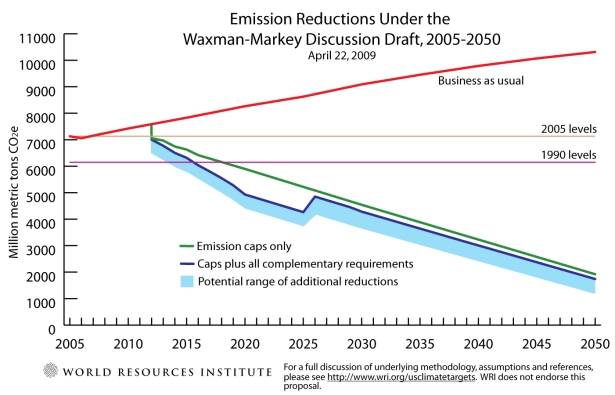This post is co-written with Sean Pool.
As the House Energy and Commerce Committee deliberations continue on the American Clean Energy and Security Act, H.R. 2454, opponents have made a number of wild charges about the cost of the bill. These claims are false. A new EPA analysis found that “compared to the draft bill, H.R. 2454 would likely result in lower allowance prices, a smaller impact on energy bills, and a smaller impact on household consumption.”
Committee opponents made a range of histrionic claims about cost, often citing partisan studies such as Heritage Foundation analyses, or a discredited study by a right-wing think tank in Spain, neither of which actually model the specific provisions of the bill. The Heritage Foundation, for example claimed that the bill would destroy over a million net jobs, impose over $1,500 in energy costs on families, and slash GDP by $9.6 trillion by 2030.
But the EPA’s nonpartisan analysis of the original bill’s more stringent environmental targets found that these outlandish predictions were wrong by a factor of eight or more. Indeed, according to the EPA, GDP would increase by more than $5.1 trillion by 2030, and costs to families would be no more than $140 per year, without even counting the reduced energy costs from efficiency and greater use of renewable energy from the sun and wind.
The EPA’s new analysis of the revised version of the bill, released on Sunday, found that recent changes to the bill would reduce its cost even further.
H.R. 2454 would bring clean energy to American families at even lower cost, while simultaneously achieving greater utilization of carbon capture and sequestration technology.
New cost-saving provisions of H.R. 2454:
— The EPA predicts that the allocation of nearly a third of emissions allowances to local distribution companies (regulated utilities) will lower the price of household bills below the modest cost from the original discussion draft. Chairman Waxman said that the new bill would cost “less than a postage stamp a day.”
– The new analysis also predicts that the price of emissions allowances will be more than 7% lower due to a 17% greenhouse gas reduction target in 2020, compared to an original target of 20%. Changes in the offsets calculations would also reduce the cost of compliance.
– Changes to the incentive structure will result in “greater penetration of coal with carbon capture and sequestration technology by 2020″ compared with the original discussion draft.
It’s no secret that both the pollution reduction goals and the renewable electricity standard are not as aggressive as in the original version. EPA found that these changes would reduce the cost of the program. Even with the lower reduction, H.R. 2454 would achieve emissions reductions equivalent to taking half a billion cars off the road. That’s twice the number of cars that exist in the US today.
The Bush-Cheney policies increased the yearly energy costs of the average American household by $1,100 while ignoring rising oil dependence and global warming pollution. While the U.S. was focused on oil, it slipped behind China in the production of solar panels, and has remained behind Denmark in the production of wind turbines. The U.S. did nothing while our economic competitors raced ahead to produce the clean energy technologies of the future.
H.R. 2454 is a bargain by comparison. Not only will it lead to energy efficiency and reduced consumption at home, but it also creates a wide variety of incentives for private sector investment in every form of clean energy technology – technologies that will lower the cost of carbon-free energy while creating jobs, increasing export revenues, and reducing our costly reliance on imported oil.



